#Creature Types
Explore tagged Tumblr posts
Text

This is the Survivor creature token. It has only been used on two cards. Those being Varchild, Betrayer of Kjeldor for Commander 2018 and, orignally, Varchild's War-Riders all the way back in Alliances (1996).


Now, can we accept that now, in 2024, it is an actual type on creature cards and have fun with that?

#mtg#magic the gathering#card types#creature types#survivors#tokens#fantasy card game#wotc#wizards of the coast
10 notes
·
View notes
Text
Welcome to the 2024 Atog Awards!

[Art by Randy Asplund]
Every year creature types are created and creature types that go unused. So what are the rules for what counts for these calculations?
(More after the break cause these posts only get longer every year!)

Types that have gone 5-9 years without print are Bronze (Fate Reforged - Throne of Eldraine)
Types that have gone 10-14 years without print are Silver (Worldwake - Khans of Tarkir)
Types that have gone 15-19 years without print are Gold (Betrayers of Kamigawa - Zendikar)
Types that have gone 20+ years without print are Cadaverrific (older then Champions of Kamigawa)
Cephalid
Before we get into new creature types, we actually lost a few creature types:
Naga
Viashino
Weasel
Now, what are our new creature types introduced in 2024?
Coyote
Skunk
Possum
Toy
Glimmer
Clown
Sloth
Synth
Beaver
Varmint
Porcupine
Mount
Armadillo
Hero
Lammasu (previously Bronze, 2014 with Khans of Tarkir)
A few creature types are no longer on this list! Those are:
Scion (previously Bronze, 2016 with Oath of the Gatewatch)
Survivor (previously Bronze, 2018 with Commander 2018)
Homarid (previously Bronze, 2018 with Dominaria)
Slith (previously Gold, 2004 with Darksteel)
Wombat (previously Cadaveriffic, 1994 with Legends)
So finally, after much delay, the current list for 2024:
Processor (2015)
Bronze (2015-2019)
Carrier (2019)
Minion (2019)
Sponge (2019)
Sculpture (2019)
Surrakar (2010)
Silver (2010-2014)
Blinkmoth (2011)
Sable (2013)
Cockatrice (2014)
Zubera (2005)
Gold (2005-2009)
Atog (2006)
Camarid (2006)
Nephilim (2006)
Triskelavite (2006)
Spike (2006)
Graveborn (2006)
Nomad (2007)
Rigger (2007)
Noggle (2008)
Tetravite (1994)
Cadaveriffic (1993-2004)
Oyster (1995)
Serf (1995)
Caribou (1995)
Ferret (1995)
Orb (1996)
Deserter (1996)
Splinter (1996)
Prism (1996)
Soltari (1998)
Thalakos (1998)
Licid (1998)
Monger (1999)
Nightstalker (2000)
Volver (2001)
Flagbearer (2001)
Mystic (2001)
Pheldagrif (2001)
Mongoose (2001)
Metathran (2001)
Orgg (2002)
Pentavite (2003)
Pincher (2004)
Bringer (2004)
SIDE NOTE: COPY PASTING FROM TUMBLR ON MOBILE IS ITS OWN LEVEL OF HELL
#uploads#mtg#magic#magic the gathering#Magic Foundations#Atog Awards#mtg arena#foundations jumpstart#duskmourn#bloomburrow#modern horizons 3#outlaws of thunder junction#murders at karlov manor#Magic Clue#secret lair#creature types#Fallout#edh#commander#Marvel#Tomb Raider#assassin's creed#Magic Assassin's Creed#I am literally the only person who cares about this#Atog
4 notes
·
View notes
Note
thoughts on tribes, both flavorwise and mechanically?
Sorry to not have gotten to this earlier, bouncing between preview seasons.
I like focuses on creature type! They're an excellent way for players to connect together cards and generate synergies without having to read the actual text or plan out lines, you just have to check that something has the right type and that it's a good card and it fits. And it tends to make more flavorful decks on average, at least on the traditional fantasy axis of different types of creatures staying segregated and self-sufficient for the most part.
I will say though, a pet peeve of mine is when WotC provides support for an underpowered or underpopulated creature type by printing an absolutely bonkers effect that only works with them. A good example of that is, I think, Magda. By doing this, WotC basically states "we don't intend to EVER actually support this creature type if you enjoy it, so hope this one card can carry you forever!". Now they can't ever actually support dwarves, because otherwise Magda would be Very Broken. And on legends, it's even worse because then it makes it really hard to make a new commander for the creature type if they ever actually want to support it, since the old one will always be better. They had this issue with trying to make a ninja commander for NEO when Yuriko exists.
11 notes
·
View notes
Text
Draconics
General Info
They are most well known by the most powerful of their kind, the Dragons themselves All Draconic creatures are descendants of the original Dragons of Mystica in some way. Draconics can be easily recognized by their reptilian features, such as scales and cold-bloodedness. Draconics come in a wide variety of different creatures, with some being humanoid and intelligent while others are closer to beasts. Draconics, such as the Kobolds or Dragonkin, have structured societies. Beasts such as the Hydra or Wyvern, are nothing more than animals that roam Mystica.
History and Culture
In the present day, “Draconic” is a label that encompasses both Dragons and their descendants. However, in the distant past, “Draconic” was only used to define the descendants of the Dragons. This is because, long ago, the first descendants of the Dragons were seen and looked down upon as separate entities from their predecessors. However, over the centuries of history, “Draconic” became the term used to encompass all Dragon-based creatures. The reason for this is etched into the very fabric of Mystica’s history.
Dragons, the Fae, and the Angelics evolved alongside each other during Mystica’s prehistory. They advanced at roughly the same time, forming their stone and bronze ages nearly simultaneously. They created their own cultures separately from one another but continued to advance through the ages. The Dragons were enamored with the concept of magic. And even though they couldn’t use it, they were determined to find a way to do so. The dragons learned to harness magic at its direct sources and use it to create magical technologies that allowed them to manipulate magic the same way the Fae or Angelics were able to. Eventually, the most advanced of the Dragons formed their own unified nation, not long after the Angelics had. The Dagons created their own country and named it Tanninim, and divided it into 12 different territories, one for each different kind of aspect that all magic was created from. Each territory was ruled by one leader, The Alpha of the territory. Each Alpha had power over their own territory and was able to make decisions based on what their people needed at any given time. The Alphas worked together to make their country a great place. Large cities were erected from the grounds as they continued to advance, with the largest ones being the capital cities of a specific territory. Soon, they realized that they were becoming more and more divided though. One Dragon decided to unify his people, a Dragon that history named Illumius. Illumius brought the Alphas together and convinced them to become unified again, and they could do so through the science of magical tech. The Alphas agreed with Illumius, and due to the citizens of Tanninim favoring his decision so much. The Alphas voted to make Illumius a leader to rule over all of Tanninim and its individual territories alongside the Alphas. Illumius became the first Master Dragon of Tanninim.
This part of Draconic history may make Illumius out to be a great leader, and to some, that’s exactly what he was. However, not all Dragons shared the same political views. Everything changed when Illumius and the Alphas decided to form an alliance with the Angelics. The Angelics had watched them from afar and admired the Dragons and their quick technological advancements. They wanted to share what they had to offer, trade with them, and even learn what the Dragons had discovered in their studies. It was well known at this time in history that the Angelics were dabbling in taboo magical studies, experimenting with living things and their magical properties. Illumius and the Alphas, seeing this as an opportunity to have, not only political power and a powerful ally, but also supplies and new knowledge, agreed to ally with them. At first, most Dragons were too happy that the economy was thriving due to this choice. The magical resources that the Dragons needed for survival were a top priority, and the Angelics, being magical generators, could give them exactly that. However, as time wore on, more and more of the academic studies of the Dragons were tainted by Angelic views. The Angelics felt superior over all life on Mystica due to their magical abilities, and the studies the Dragons were doing were starting to reflect exactly that. It became apparent that many of the experiments and research that were taking place in Tanninim were becoming corrupt and immoral. The Alphas and Illumius did not care for the immorality of the situation though, for they were wealthy and powerful in comparison to their people.
Illlumius’s main priority though was to learn all that he could, and the Angelics were showing him more than what was previously known to him. They destroyed his morality because he willingly pushed himself to his limits with his independent studies. Illumius became mad, losing himself in research. It corrupted him to his very core. When he was able to discover magic that granted him effective immortality, a power that allowed him to halt the aging process and make him immune to all diseases, that was when he snapped. He no longer valued life in the same way that he once did, not seeing a point in unity if his word was law and death as a near impossibility. He shared his power with the Alphas. Now they could no longer age or die from any disease, only a direct killing blow could end them. They kept their discovery secret for years, centuries even. Their citizens took notice of their lack of aging capabilities and grew suspicious. With a corrupt government and their morals being put in constant jeopardy, they formed a rebellion.
This rebellion was led by a Dragon known as General Hemocitus. Hemocritus was a well-known general for the Tanninim military, and once he discovered that their leaders were hiding effective immortality from his people, he took to the skies and shouted what he knew to all who could hear. Word spread like wildfire, and the people of Tanninim were not happy. Hemocritus relieved himself of his duties, refusing to fight for a country that was led by corruption. Between the immoral teachings, the spread of Angelic rhetoric, to the ignorance of their people, he had had enough. He retreated into the wilds, but many followed in his path. Because so many Dragons were following in Hemocritus’s footsteps, the leaders of Tanninim became fearful. Assassination was their biggest worry at this point in their lives due to it being the only logical way they could foresee their end. They decided to make their government system stricter, punishing anyone who said anything good about Hemocritus and his followers or anything bad about Tanninim. Many Dragons were beaten in the streets for their protests, killed even. This led many to escape their cities, retreating to the wilds of Tanninim. There, many searched for Hemocritus and his followers. Eventually, Hemocritus had an army. Hemocritus formed a large-scale rebellion against the leaders of Tanninim and announced a civil war.
This war lasted a near century, now being known as The Great Destruction in Mystica’s history books. The Great Destruction decimated countless Dragon cities and countless lives were lost. As the war grew more and more bitter, Illumius promised all who joined his side of the fight the key to effective immortality. This convinced many Dragons to fight against the rebels. However, the rebels continued to grow in number. At the height of the war, the Rebels planned a large-scale attack on the capital of Tanninim. It was successful, but as Hemocritus made the advancement to finally take back his people’s county, Illlumius and the Alphas had already taken their final stand. They had a backup plan for when things looked like they did now. They gathered in the city’s sky, calling off their army for a retreat. The rebels thought it was a surrender, and started to celebrate. Their celebration was too soon though. Illumius revealed a weapon to the celebrating crowd, but as Hemocritus called for an immediate retreat, Illumius activated the device. A massive beam of uncontained magic engrossed the city. The resulting explosion destroyed the once-beautiful settlement, but the leaders and their followers were able to escape the blast in time.
Once the smoke had cleared, they returned to the remains of the city, expecting the rebels to be nothing but ash. However, as bodies pulled themselves out of the rubble, the Dragons realized that the magic did not work as intended. The rebels were very much alive, though they could no longer call themselves Dragons. Their forms were warped into humanoid shapes merely inspired by their reptilian bodies. They were smaller and much weaker than they once were, but alive nonetheless. These newly created bodies of the rebels were surprising to the Dragons, but they were not disappointed. They had won the war, after all, and these pests did not have any chance against such a powerful reptile, such as a Dragon.
Hemocritus was forgotten about by Illumius, and as he had his back turned to admire his work, Hemocratus was able to land a blow with a magical weapon that pierced his effectively immortal heart. Illlumius dropped dead. The Alphas were shocked, but called their army to kill the remaining rebels. The rebels scattered, some of them were caught, but many were able to escape into the wilds of Tanninim. Hemocratus was not one of the lucky ones. He was beheaded the next day, a testament to what happens to those who cross the Dragons.
The remaining rebels eventually were able to form their own groups of people and escape from Tanninim altogether. These people were the first of the ancient Draconics. These groups of people eventually formed their own small settlements outside of Tanninim’s borders. But being separated, both in appearance and in distance, they were all independent of each other. Those who traveled together could no longer recognize each other by appearance alone, for their bodies were warped far too much. The ways that they were warped had similarities, and they were able to defer that they were separated into four unique groups. These groups were known as the Dragonkin, the Gex, the Kobolds, and the Raptors. They were able to identify that the reason for their grouped appearances was due to certain beliefs that they held in their hearts, not any other factors. And because their beliefs were so vastly different, and the directions they wanted to take their people conflicted with each other, they split up their once unified society into each of these four races.
The Dragonkin’s belief was that they wanted to rebuild their once great civilization and revert back to a 12-leader system instead of a 13-leader one. They felt that the most prominent change that needed to be made was to let the citizens decide how their governments should be run instead of just what their leaders wanted for their people. However, they wanted their leaders to represent the people of their respective territories. The Gex found this to be ineffective, wanting the government to play only a small part in their lives, only existing to help fund what their people needed and nothing more. They felt that the goal of even having a government was so the people could eventually run the country with no definitive leader and that the communities would provide each other with what was needed, the government holding no power other than to help set up a system where this would work. The Gex thought that it would disband once everything was set up properly. The Kobolds felt that not having someone to lead them would make life difficult for their people and that a no-government system would prove ineffective. They thought that the small government system that the Gex had discussed would eventually take over. The Kobolds concluded that eventually, the government would rise up from this no-government system to lead their people, maybe even tyrannically lead them instead. However, they felt that the 12-leader system the Dragonkin had agreed upon would only lead to separation and that they needed one leader to unify them once again. The Kobolds believed that the people should decide who should lead them. The Raptors, instead, thought that separation was key, and they wanted to abandon magic and all the damage it had caused. They didn’t want traditions to fog their minds and corrupt them once again. They wanted a drastic change, and that change would be found away from a large-scale government system. They agreed with the Gex that communities should help each other, but each community should have its own leader to direct its people in some way. They had planned that the best way to do that was to create small-scale, independent communities that communicated with each other as if they were different nations altogether. These communities would still be united by blood, and that to them was enough of a reason to still call themselves one unified nation.
Because each race had their own different ideas on where they wanted to take their new society, and no compromise was worked out, each race separated from the others in a peaceful manner. They came to one agreement during their arguing, that they had been through hell and that they wouldn’t let a disagreement such as this ruin their relationship. They may hold different beliefs, but they still shared the same experiences and hatred for their previous government system. They separated, but not on a sour note. They all remain close to each other, even in the present day, due to their history.
Each race formed its own civilizations exactly as they had envisioned them. Each one had its successes and faults to them, but they made it work. Though many centuries of surviving independently from Tanninim, they developed their own forms of culture that were inspired by their new experiences and their previous Dragon traditions. The Dragonkin embraced their old traditions while creating new ones. They created the nation of Pyre. They embraced Hemocritus’s teachings and saw him as a war hero that led to their freedom. In his name, they made many crusades against Tanninim, now a much weaker country than it once was. They took back many pieces of ancient territory that were special to them, including the reminder of their once great capital city. They rebuilt many of the old cities, but not every piece was salvageable. The Gex weren’t as traditional or warfaring with their ways as the Dragonkin were, finding that many of these practices were part of the problems that once plagued them when they inhabited Tanninim. They kept their love of magic though, finding that magic was still an extremely important factor in their lives and in survival. They weren’t as advanced as the dragons, finding that research with no purpose to help their people caused more harm than good. They settled in the Hisstic Desert, claiming a small territory that comprised of a nearby sea, a large river, rocky terrain, and hot sands. They named their country Gillan. They found that their new bodies preferred the hot, dry climate, and the humidity from the waters that ran through this country kept the surrounding areas rich with life. They settled near the river that ran through their land and the sea that it lead to. The water connected them, giving them a means for agriculture and hydration. They became close with the aquatic Fae that inhabited this great land. The Kobolds took to the mountains and the temperate rainforests that surrounded them. They grouped together in large numbers, creating settlements in the hills and rocky cliff faces that had great roads connecting each of them. They named their country Aznak. Aznak never became as large as Pyre or Gillan, but it became a major place of trade. Kobolds didn’t have a close connection to their old traditions or to magic, instead, they focused on keeping themselves alive and their people fed. They used the hills of Aznak to farm native root vegetables and the small fields to farm and domesticate the native herbivorous beast of the land. They became prominent meat farmers and their primary trade good was animal products and precious stones from the mountains. The Raptors abandoned their old ways, too disgusted by the Dragon’s atrocities. They created their own traditions and felt that magic was a force that was not to be messed with. They still valued magic and needed it for survival though, so they didn't hate it by any means. Instead, they saw it as a powerful force of nature that shouldn’t be looked too deeply into. They settled in a jungle, rich with magical energy. They named their new country Iribus. They used the woods of the trees that surrounded them to their advantage, creating small clearings to house their towns and even building in a way that incorporated nature. They became very close with the Fey that inhabited the forest, the Fey finding their way of life to be respectful.
The Dargons that still inhabited Tannninim went quiet after The Great Destruction, now that all of them were effectively immortal, they no longer needed to worry about what they once had. The Dragonkin became their only true fear, and they lost many of the battles that the Dragonkin instigated during their crusades due to their newfound fear of death. Dragons became reclusive after many centuries. The Dragons only were able to keep themselves sane through their magical advancements though. Some Dragons took to the other parts of Mystica, outside of Tanninim to conduct their research or to escape the past, many never returning to their homeland. The most prominent problem that the Alphas, now known as The Great Counsel of Tanninim, was the massive population boom after the civil war. Fewer dragons were dying, with murder and natural disasters being the only major cause of death now that other means were ineffective against them. New dragons still hatched from eggs at the same rate, if not at a greater rate, than they had previously. This created a great decline in magical resources due to the sheer amount of Dragons inhabiting Tanninim. The Angelics, seeing them as no longer worth their time, refused to trade with them. They were starving because there were too many mouths to feed. The GCT took to killing the weak off to keep their numbers down. To do this, they decided that all young Dragons now were forced into the wilds of Mystica to test their strength. Their goal was to survive. They weren’t to return home until they brought back the head of another young Dragon. With nature killing these young dragons, and with their goal to be to kill off others of their kind, the population was no longer as large as it once was. However, this new cultural lifestyle caused the Dragons to fear others of their kind, not trusting them due to their upbringing when they were young. This solved the population problem temporarily, and the GCT knew that. They also knew they had a severe crime problem due to Dragons no longer caring about harming others so long as it benefited themselves. The GCT decided to imprison and experiment on all who committed any sort of crime. The experiments that were conducted on these criminals, even minor offenders, led to the deaths of many. This solved their population issue. On top of that, they continued to work, inspired by what they learned from The Great Destruction. They used their teaching to create more Draconic creatures, similar to the ones that resulted from The Great Destruction. They broke down the minds of the imprisoned Dragon’s, causing their beliefs to fade away due to their torture. When they used similar magic on these prisoners that they had on the rebel Dragons of history’s past, they were transfigured into beasts. They created the Wyverns, the Hydra, the Drakes, the Wyrms, and the Lavaithans as a result of this. Their goal was to create a group of beasts that would follow their orders and be their drones. These Draconic beasts were animalistic but intelligent enough to understand speech to carry out tasks. They were created to be subservient, and they were partially successful. The Dragons used them to keep their citizens in fear, their artificial soldiers always overshadowing them and policing them in a tyrannical way. However, many of these Draconic beasts weren’t as loyal as they had planned them to be. Certain individual beasts escaped into the wilds, becoming one with the other fauna of Mystica. This chaos caused the remaining Dragons to flee the grips of the GCT, with very few holding any loyalty toward their leaders. These dragons are now considered to be wild creatures, the same as the wild Fae of Mystica. They are intelligent, and sentient, but have settled alone in nature so that they could be free from others of their kind. The Dragons became loners, only meeting up with others of their kind to breed or fight for territory. The remaining Dragons of Tanninim were also reclusive, no longer dwelling in cities or other societal structures.
Tanninim in the present day is a small country, having been mostly taken back by the Dragonkin. The GCT lives in hiding in the underground structures of Tanninim, as do many other Dragons. Dragons conduct trade with the other nations of Mystica, with their technology being their main export. Next to the Angelics, Dwarves, and Elves, they are still the most technologically advanced of the many races of Mystica. They exchange their tech for magical resources and food to keep themselves alive as long as possible. Young dragons are rare in Tanninim, and eggs are frowned upon to create. They only reproduce if the GCT has decided that the population is too small. They continue to send their young into the wilds regardless, the GCT still only wanting the strongest members to live amongst them. Many don’t return home.
Abilities and Biology
All Draconics are natural destroyers of magic. Much like the Fae, they need magic to use certain bodily processes and need to consume it to survive. However, they are unable to use the magic that is stored in their bodies in the same way the Fae can, for they are not manipulators of magic. The most they can do with any of the magic stored in their bodies is expel it through their breath. All Draconics are able to expel their stored magic in this fashion, breathing it out in mass quantities. Its main purpose in evolution was to act as a defense mechanism, but it also works to regulate the amount of excess magic in their bodies. Breath weapons, such as these, have different strengths depending on the Draconic creature in question. Dragons, for instance, have the strongest breath weapons. However, Kobolds have the weakest of the Draconic breath weapons. Each breath weapon has a different way of forming depending on the individual Draconic creature. The type of creature determines the type of breath weapon they will have. The only exceptions to this rule are the Dragons, Wyverns, and the Dragonkin, whose breath is determined by what aspect they are personally bound to. Most other Draconics have a predefined type of breath for their species, with the firey breaths of Drakes, the expulsion of raw magic of the Gex, or the Hydra’s acid spay.
Draconics absorb magic into their bodies by directly consuming it at its source. They are able to breathe it in through the air to fuel their bodies, but it is much more effective to consume things that contain magic within them. Dragons will eat precious gemstones, certain magical plants, and even other magical creatures in order to retrieve magical energy. Many Draconics will hunt certain species of wild Fae or Angelic-bound creatures since they are so abundant in magic. Eating creatures tends to be the most effective means of consuming magic since it also allows them to eat real food as well. Most Draconics are primarily carnivorous for this very reason. Not all Draconics are carnivorous though, such as the Omnivorouse Gex and Kobolds. All Draconics can detect magic by using their Jacobson’s organ. They use their tongue to pick up particles of magic and smell them using this organ to detect nearby magic in their surroundings, as well as other sents. Certain Draconics can even detect how much of a certain aspect is traveling within this magic, as long as they are skilled enough.
Because their bodies use so much magic, it doesn’t leave them enough to use for magic manipulation. They simply never evolved this trait, and thus, they cannot cast spells. They can use their breath weapon, however, doing so in large quantities will leave them in a weakened state. The breaths of certain Draconics are typically only used in dire situations or for ceremonial purposes. Some even refuse to use it at all, such as with the Raptors of Iribus. Others, such as the Dragonkin, use it to show a display of strength during battle or during certain rights of passage. Draconic beasts will use them for fighting enemies, such as the Hydra or Wyrm. A Draconic who is weak in magical energy is effectively starving themselves, and eventually, their bodies will shut down.
List of Draconic Creatures
(not final)
Dragons
Dragonkin
Drakes
Gex
Hydra
Kobolds
Raptors
Serpents
Wyrms
Wyverns
#drconics#spiecies#creature types#dungeonstuck#ttrpg#dnd#dungeons and dragons#table top#table top games
5 notes
·
View notes
Text

Seasons Greasons! I couldn't get this photo of Belphie and Pangur from @pangur-and-grim of my head, so I used it as practice for my new colored pencils!
#your cats are so shaped i love them. pangurs just like >:O#traditional art#colored pencil#cats#also its my first time shading a creature of belphies ah... texture. but the undertones are so so fun lmao#new favorite type of cat to render. sorry white cats. sorry pangur.
4K notes
·
View notes
Text
Feeling compelled to take a moment to document this saddest looking little dog I saw today.

#I'm sure the dog was fine some of them just inherently look like victorian street urchins#it had such big wet humanlike eyes#own art#could've been a chihuahua cross of some kind#no neck stick legs bread loaf torso type of creature#dog sightings
9K notes
·
View notes
Text
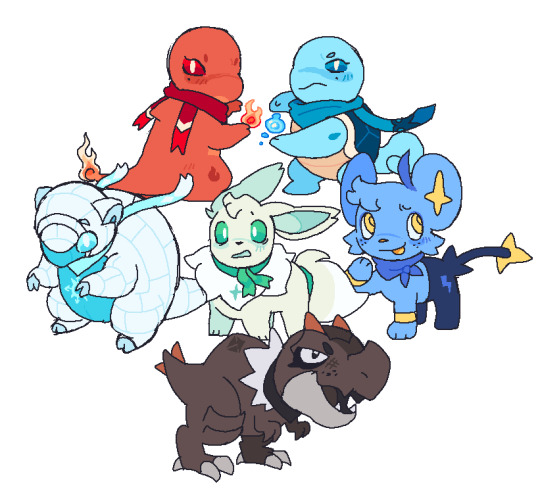
pokeninjago....
#ninjago#pokemon#potatart#lloyd garmadon#nya smith#kai smith#zane ninjago#jay walker#cole brookstone#cole ninjago#imaginng this is like a pmd type situation#theyre all so. l#creature#ouugh#im so tired
1K notes
·
View notes
Text
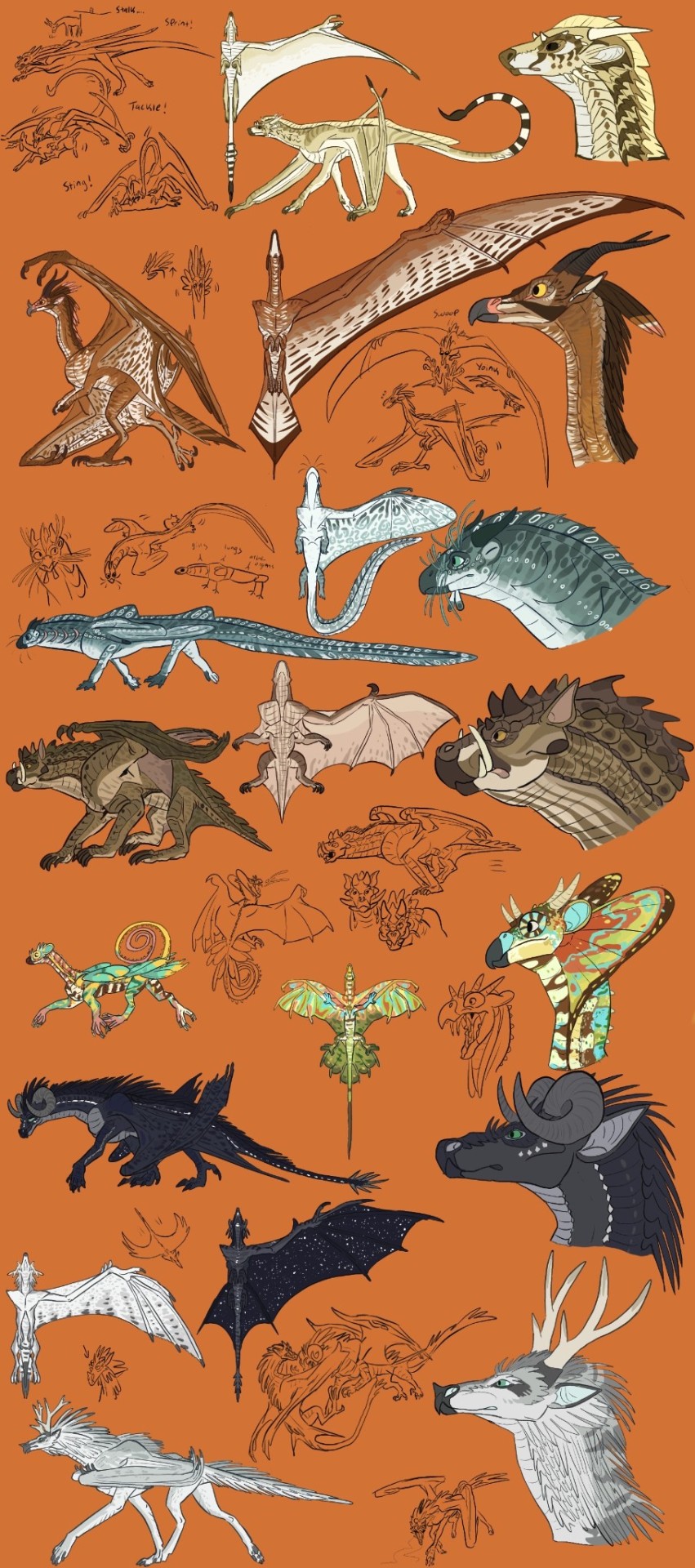
While it's on the mind, here's my wings of fire designs too. Not as much of a brainrot but still fun. Bad take or am I cooking with some of them? Let me know in the comments. Here's some (too many) notes:
I really liked the original designs when I first read these books, but I wanted to try my hand at uhh changing them a little. Mainly making them more distinct from each other (even if this irreversibly breaks canon XD)
-Sandwings live in a mixed savannah and desert habitat and have bodies adapted for resource scarcity, effective hunting, and heat dispersion. They have large ears to help cool off and listen for stuff. They can fly, but pretty weakly in comparison to some others, mainly using flight to navigate their large territories , get onto cliffs, and scan for prey. They typically climb up somewhere and then jump off. They are built like felines, and use a solo stalk and rushdown hunting approach coupled with a sting instakill. They live in family groups, with a ‘queen’ title going to the alpha female 💪 and everyone else hunting and living together. They are immune to their own venom, which acts very similarly to a scorpion’s but in a massive dose, causing numbness, breathing difficulties seizures, and eventually death. It takes time for them to make more once they’ve expended the dose, so they rarely use it outside of hunting or life/death situations (though the prospect of being stung is very scary to everyone else, and they will instinctively raise their tail when startled or threatened)
-Skywings live in high mountainous and forested areas, with some living in the lowlands. They are powerful flyers and very acrobatic due to their tail, though this comes at the expense of their agility on land and the strength of their non wing arms. They have long legs with powerful talons for grasping prey midair or snatching them from off the ground. They hunt and live alone unless they have a partner. Communities are made up of a loose group of related individuals who rarely collect in one place at once(queendom structure are a more recent and ‘unnatural’ thing for them, but very useful for organizing military efforts and empire building). They stay aloft for long periods of time and usually only land on their cliff homes. They need a sprint or a takeoff point to get flying, though. Unlike every other tribe, they have a noticeable difference between male and female (being a nose horn and red face for males.) males are prized for these features, and having a pretty husband is seen as an attractive trait for a queen.
-Seawings live along the coast. They normally only venture out of the water for trade and other resources, since they can get everything else they need underwater. Their large neck houses gills protected by thick pads that will close when on land, while their lungs are in their mid chest. Primarily adapted to swimming, they have very strong tails and webbed fingers and toes. They will also use their wings to steer and paddle, as well as manipulate things their other arms can’t reach. They will hunt in packs, corralling fish and other animals into a kill zone. They are very clumsy on land and in the air with their short limbs and weak wings. Their bioluminescent spots can be flashed for communication, and compared to the other tribes they have pretty poor vocal ability (due to the gills in their neck getting in the way) and will supplement with other spot/sign signals. Every individual has unique spots, though their glowing ones come in consistent numbers, sizes, patterns, and places on their body so they can use them for common language across their group. However, Different groups from different parts of the ocean have different numbers of spots in different areas, making cross communication via only spots difficult. Their whiskers help navigate in close or dark areas, and are seen as a status symbol.
-Mudwings live in warmer areas, specifically marshes and other wetlands (though sometimes in some forested areas too). Their thick armor helps protect them from other mudwings/competition, while also acting as an insulator that allows them to easily venture a wider range than other tribes from warm climates. Physically, they are the strongest and bulkiest. They typically use the element of surprise and their overwhelming size and strength to take down large prey. However, unlike other tribes they tend to eat more plants too due to their large size (all of them are technically omnivores, but meat makes up the dominant part of their diet because of their energy needs and their ancestors). They are also the poorest flyers out of the bunch, having sacrificed that for size and strength, though they can do short bursts similar to a chicken to get to hard to reach areas or to surprise attack prey faster than them, they’re similar to hippos and are adapted to living in the water too, using powerful webbed arms to propel themselves and dig through the mud, and their large lung capacity to stay submerged and hidden for long periods. Their nostrils, ears, and eyes are located near the top of their head, which also gives more room for Tusks. They use these to root around occasionally defend themselves. Tusk maintenance and appearance is very important to them. They live in large groups of families in the same area and have more communal social standards than other tribes.
-Rainwings live in tropical areas and have a very small habitat range. This has caused them to look and act very different than most tribes, leading to poor perception of them. They use their long claws, strong grasping fingers, and prehensile tail to climb around, and are pretty much arboreal. They have wings meant for quick takeoffs and flight in dense areas, and are pretty agile and swift. They and aren’t that great at sustained flight or dealing with high altitudes and winds though . Their frill is delicate and used for emoting (probably originally for mating purposes) Their skin is packed with chromatophores that they can use to match their surroundings, and they have loose ridges in their skin that they can raise to enhance the effect. Their skin is constantly changing color due to their brain activity, though they have set patterns/colors for emotions and communication. They can also choose to focus on organizing their skin patterns to get coordinated colors and patterns, since normally it’s pretty disorganized. They eat a lot more plants due to their environment and due to social standards, but arent herbivores. They have the ability to spit acid out of hollow retractable fangs, and use precise shots of this coupled with their camouflage ability to get prey. They can also spray it at higher velocities for defense and offense, though this expends their supply much quicker. They don’t recognize a queen in their communities and are fairly disorganized into different cooperative groups.
-Nightwings are the result of a group that split off onto an island, though the volcanic activity on their original island escalated to the point where they had to emigrate. They are great fliers, using their wings and tail extensions to travel great distances to track prey and ambush from above. When on land, they aren’t particularly fast or strong, and instead are built for persistence. Their hunting tactic involves getting an initial bite onto prey, then waiting for it to succumb to infection. Their spines, horns, muscles, and talons are mainly for defending their kill from other Nightwings rather than hunting it in the first place. As a result of this competition, they aren’t naturally very social like other tribes, They are mainly nocturnal.
-Icewings live in the colder tundras and snowy forest environments. They are pack hunters, using their speed and persistence to take down prey, similar to wolves. Their long overlapping scales help them trap heat and survive in the cold, and while the guy i drew here is pretty skinny they also store fat much more readily than other tribes. Their bowed wings are mainly used to swoop in in prey, and like falcons they often take steep dives to grapple it. Their antlers only grow in at a certain time in the year, but royalty will wear embellished artificial ones in the meantime.
#my two vasly different dragon media interests#the httyd book dragons are also intelligent but unlike the wof ones i never imagine them wearing clothes and theyre never referenced#using tools or really wearing jewlery or building things they live in packs like animals but many of them can carry on a convo with a human#comparatively id say that the main difference is that the wof have a distinct grouping and relationship between the types of dragon while#in the httyd books those guys are just Everywhere and Everything#and also Humans are a major part of httyd while theyre just kinda weird little creatures in wof#wof art#wings of fire#wof#drawing
1K notes
·
View notes
Text



very specific au thought, silver if he was the shield instead ( read the tags to see explanations )
#reading chapter 7 updates back to back on both servers YEEHAW#essentially shield silver is just silver but with his backstory has elements from yuulis' backstory#or like. the silver owl's kingdom falls apart much much more disastrously#so silver is!! essentially the same type of creature that yuulis is hnm hnm#he's less proficient in swordplay so sebek beats his ass in sparring#but he makes up for it in magic!! hes at least twice/thrice better than his og incarnation#though he lacks self confidence bcs hes surrounded by fae like malleus n lilia who r just. innately good at magic#he has thick arm guards instead of the regular diasomnia gloves#bcs his he needs protection for his feeble human arms#( jk he's still as muscular as normal silver bcs he has to swing that big staff around )#was gonna make the shoulder pad on his right to make him mirror the knight of dawn but it bugged me too much grrrrr#his clothes r also more loose but still not restrictive#without saying much#shield silver is closer to malleus than the og!! he imitates malleus' mannerisms a lot when casting spells. like the floaty thing mal does#also indirect yuulis lore ig#shield silver always covers up ( like malleus cards ) bcs he's got a mega complex about his stitches#unlike yuulis he has no means of rlly hiding his stitches by himself#so he's under an illusion spell ( cast by malleus ) where to the regular person he looks like a regular human#also when he overblots. he becomes the phantom himself ( indirect yuulis lore part 2 )#hence why.. fucked up looking creature in the last image#tahst enough rambling from me hehe live laugh love#twst#twisted wonderland#twst silver#sebek zigvolt#twst grim#twst yuu
471 notes
·
View notes
Text

Silly things to do with his silly cape
#dcmk#dcmk fanart#detective conan#cokid#kidcon#kaito kid#edogawa conan#also i need more people draw kid with short sleeves#i'm the type to obsess with detail change so yea#that flying squirrel creature isn't much accurate but i tried my best#summer kid#this is what i gonna call whenevr i draw him with short sleeves
680 notes
·
View notes
Text
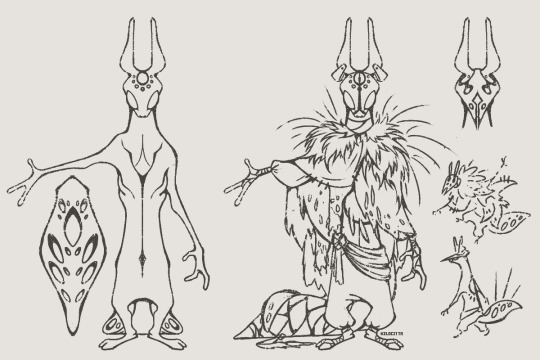
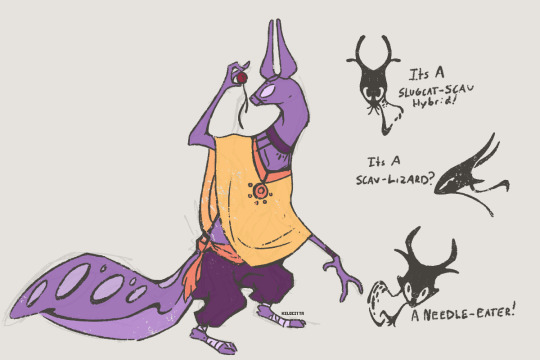
Anthro Spearmaster.... Slugscav? Scavlizard? All of the above? Something else? No ones quite sure.
Spearmaster presented another interesting conflict similar to Artificer, where if you make them one-to-one you end up making someone (Suns) look a lot more fucked up than they really are. Since while, regardless of how you feel about animal experimentation, you can probably agree its less fucked up than human experimentation. But get rid of too much and you lose what makes Spearmaster Spearmaster- So they certainly aren't an ethical creation, but a little less unethical than literally removing a creatures mouth and making it feed via bone needles. Still not a normal slugcat by any means, and one that uses that to their advantage. Local towns see them as everything from a normal individual, to a weird hybrid, to something entirely supernatural. They keep the details to themselves and their iterator and are happy that way.
#rain world#rainworld#rw anthro#rain world downpour#They have a jaw but muscle weakness prevents them from using it fully. So while not physically mute they cant speak easily#they have a number of braces they use to hold it shut normally and do still live on a liquid diet#just not one that requires feeding through their tail! but they can still produce and use needles from it#also drier skin than a normal slugcats means theyre less slippery and not as smooth#the overall idea was to make them essentially a bit of a yokai type creature for most of the populace. A bit more of a weird hermit
657 notes
·
View notes
Text


There's no previous Green-White Rabbits before Bloomburrow, so just remember to consider the one White-Black Bat and Black-Green Squirrel to come before.
#mtg#magic the gathering#color pairs#creature types#bloomburrow#kindred types#fantasy card game#wotc#wizards of the coast
16 notes
·
View notes
Text
Welcome to the 2023 Atog Awards!
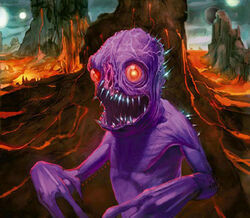
Every year creature types are created and creature types that go unused. So what are the rules for what counts for these calculations?
The creature type has to have at least 1 Black-bordered card that either is, produces a token of, or mentions the creature type.
Reprints don't count. Only new cards being produced.
Creature types of older cards are based off of their current creature types as of Lost Caverns of Ixalan. (There are creature types like Thalakos that have been errata'd onto older cards but have technically never been printed on a physical card)
Changelings / Mistform Ultimus obviously don't count.
Arena exclusive cards do not count.
Silver bordered / Acorn Stamps / Play test cards don't count.
Types that have gone 5-9 years without print are Bronze (Born of the Gods - Guilds of Ravnica)
Types that have gone 10-14 years without print are Silver (Conflux- Theros)
Types that have gone 15-19 years without print are Gold (Darksteel - Shards of Alara)
Types that have gone 20+ years are Cadaverrific. (Mirrodin and older)
So what are our new types?
Time Lord
Doctor
Dalek
Cyberman
Capybara
Llama
Snail
Mite
Detective
Scientist
Bronze
Cockatrice (2014)
Lammasu (2014)
Processor (2015)
Scion (2016)
Survivor (2018)
Homarid (2018)
Silver
Surrakar (2010)
Blinkmoth (2011)
Sable (2013)
Gold
Bringer (2004)
Slith (2004)
Pincher (2004)
Zubera (2005)
Atog (2006)
Aurochs (2006)
Camarid (2006)
Nephilim (2006)
Triskelevite (2006)
Spike (2006)
Graveborn (2006)
Nomad (2007)
Rigger (2007)
Noggle (2008)
Cadaverrific
Tetravite (1994)
Wombat (1994)
Oyster (1995)
Serf (1995)
Caribou (1995)
Ferret (1995)
Orb (1996)
Deserter (1996)
Prism (1996)
Splinter (1996)
Soltari (1998)
Thalakos (1998)
Licid (1998)
Monger (1999)
Nightstalker (2000)
Volver (2001)
Flagbearer (2001)
Mystic (2001)
Pheldagrif (2001)
Mongoose (2001)
Metathran (2001)
Orgg (2002)
Pentavite (2003)
Broke free
Aetherborn (2017)
Nautilus (2015)
Rebel (2007)
Spellshaper (2007)
#mtg#uploads#magic the gathering#magic#edh#march of the machine#phyrexia#all will be one#mtg arena#lotr#lord of the rings#doctor who#commander#wilds of eldraine#lost caverns of ixalan#creature types#atog awards#text post
8 notes
·
View notes
Text



Watched Pyramids of Mars and... yeah I'm obsessed with this guy
#Was inspired by The-Patrex's fantastic anthro drawings of Sutekh. Absolutely check them out they are SICK!!!#He's anthro. he has a good voice. and he's an ancient creature of pure evil... so exactly my type really :''')#Whats super interesting is how the versions differ in interpreting Sutekh's 'Set creature' appearence.#PoM has a much more on the ardvark/giraffe elements. With the thin snout and very stylised square ears#whereas LORS is much more canine. Though still not conforming to any specific species. With the appearence of something mummified#its very good. I love both#Doctor who#Sutekh#dw spoilers#pyramids of mars#classic who#lors#the legend of ruby sunday#furry#art#dw#spoilers#fanart#fan art#dr who#antrho
817 notes
·
View notes
Text
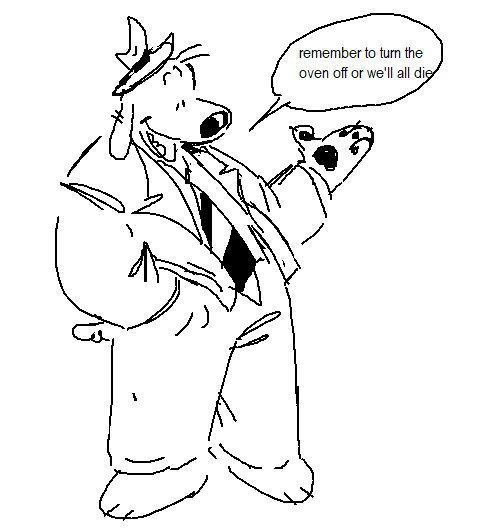
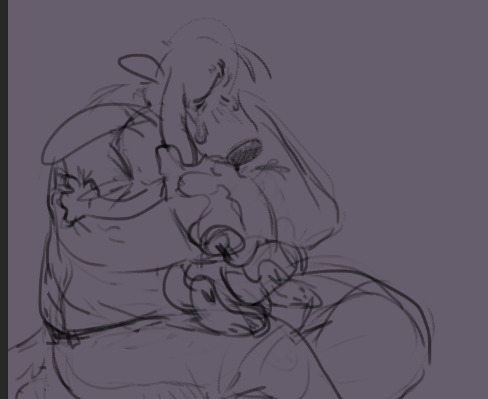
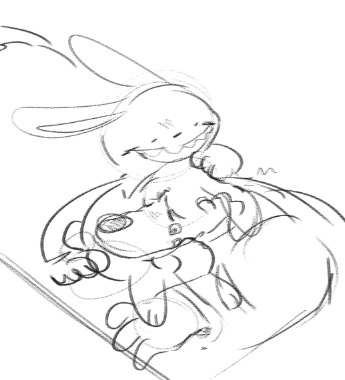
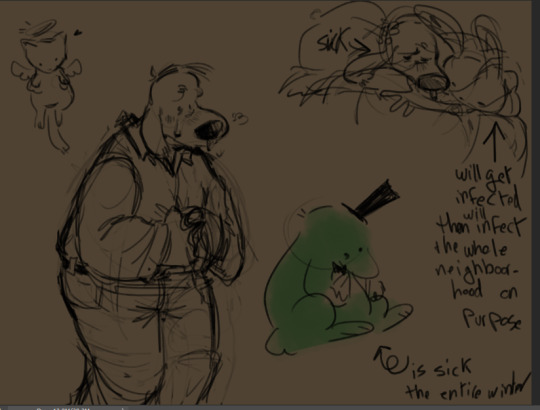
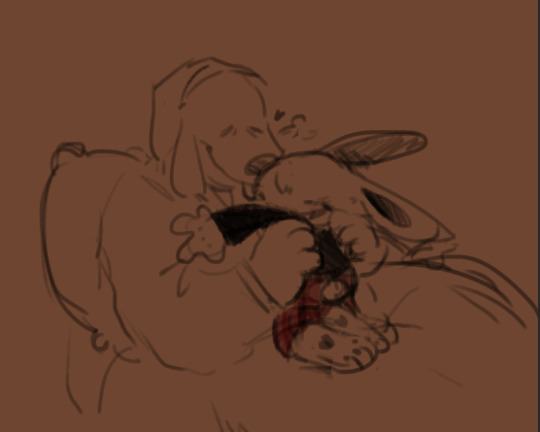
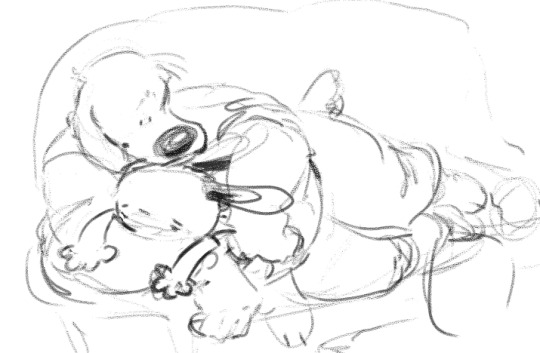
I wanna put those guys in a blender
#sam and max#sam and max freelance police#freelance police#my art#narnour's art#was gonna say this is ooc but then this is the only type of content I've been serving here for almost the past three years#so it's not really new if you spent over 7 seconds on this blog#green creature is a sona I never introduced#dumppp
1K notes
·
View notes
Text
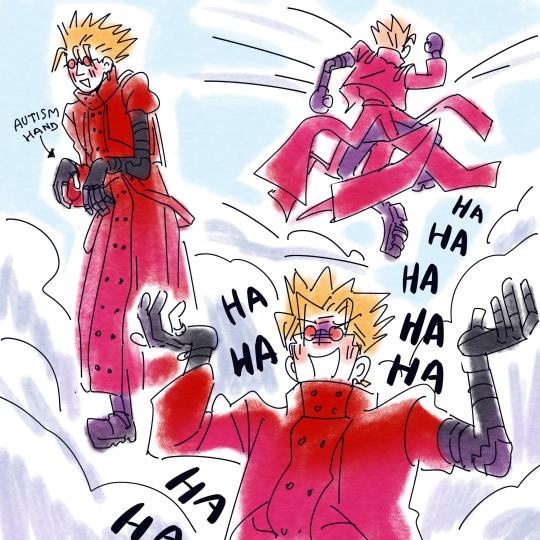
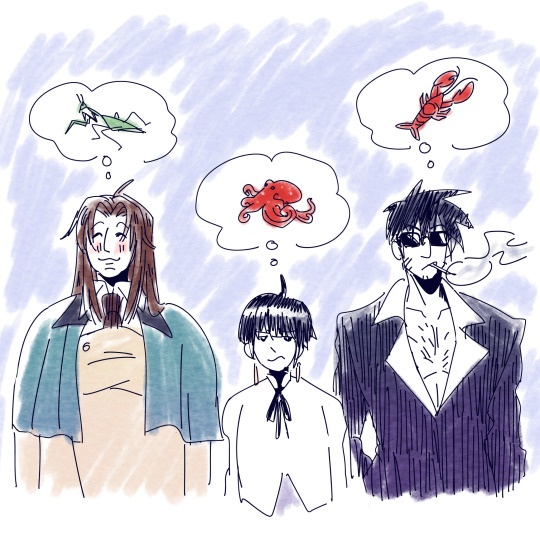
Some sort of creature… (ID in alt text)
#Ignore the fact that most likely no one has any knowledge of what a sea creature is#he’s deep ocean type of weird#alexxuun#trigun#trigun fanart#trigun maximum#trigun 98#vash the stampede#milly thompson#meryl stryfe#nicholas d. wolfwood
3K notes
·
View notes